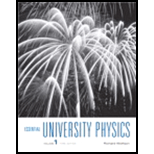
Concept explainers
To explain: Why do nuclei contain the particle neutrons.
Answer to Problem 1FTD
The neutrons are existing in the nucleus to reduce the effective electrostatic repulsion between the protons so that the nucleus can exist in a stable state.
Explanation of Solution
The neutrons and protons constitute the nuclear structure. Protons are positively charged particles and there exist electrostatic repulsion between the protons inside the nucleus. The nuclear structure cannot be stable unless the repulsion between the protons is minimum. In order to reduce the repulsion, the protons cannot go as far apart as possible. Hence there is a requirement of some neutral entity (some particle) so that they fill the nuclear structure along with the protons so that the density of protons in the nuclear volume is reduced and thereby the strength of repulsion.
For lighter nuclei, there exist neutrons, which are equal in number of protons. However, for heavier nucleus the number of neutrons are higher than that of protons in order to reduce the high repulsion and to keep the nuclear density a constant.
Conclusion:
Therefore, the neutrons are existing in the nucleus to reduce the effective electrostatic repulsion between the protons so that the nucleus can exist in a stable state.
Want to see more full solutions like this?
Chapter 38 Solutions
Essentials University Physics, Volume 1 and 2 - With Modified MasteringPhysics Access
 Glencoe Physics: Principles and Problems, Student...PhysicsISBN:9780078807213Author:Paul W. ZitzewitzPublisher:Glencoe/McGraw-Hill
Glencoe Physics: Principles and Problems, Student...PhysicsISBN:9780078807213Author:Paul W. ZitzewitzPublisher:Glencoe/McGraw-Hill An Introduction to Physical SciencePhysicsISBN:9781305079137Author:James Shipman, Jerry D. Wilson, Charles A. Higgins, Omar TorresPublisher:Cengage Learning
An Introduction to Physical SciencePhysicsISBN:9781305079137Author:James Shipman, Jerry D. Wilson, Charles A. Higgins, Omar TorresPublisher:Cengage Learning Modern PhysicsPhysicsISBN:9781111794378Author:Raymond A. Serway, Clement J. Moses, Curt A. MoyerPublisher:Cengage Learning
Modern PhysicsPhysicsISBN:9781111794378Author:Raymond A. Serway, Clement J. Moses, Curt A. MoyerPublisher:Cengage Learning Principles of Physics: A Calculus-Based TextPhysicsISBN:9781133104261Author:Raymond A. Serway, John W. JewettPublisher:Cengage Learning
Principles of Physics: A Calculus-Based TextPhysicsISBN:9781133104261Author:Raymond A. Serway, John W. JewettPublisher:Cengage Learning



